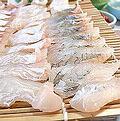 一名舊金山醫師海陶爾(Jane Hightower)最近出版新書指出,美國食品及藥物管理局(FDA)規定的人體汞攝入標準,並沒有考量魚肉中低濃度汞可能造成的傷害。
一名舊金山醫師海陶爾(Jane Hightower)最近出版新書指出,美國食品及藥物管理局(FDA)規定的人體汞攝入標準,並沒有考量魚肉中低濃度汞可能造成的傷害。
海陶爾表示:「問題在於,我們無從得知餐廳或商店裡常見的魚類有多少汞,大部分消費者並沒有意識到餐桌上的魚可能致病。」
她是第一個觀察到食用特定幾種魚類的病人,體內殘留有低劑量汞,且出現相同病徵。
海陶爾醫師的研究正從少數病人個案拓展到面臨汞污染問題的日本、加拿大和伊拉克。她認為FDA的汞攝入標準是根據一份「海珊執政時期的甲基汞食物中毒事件」之研究報告,可是該中毒事件中的食物並非魚,而是麥子。
她提出警告:「當年監督汞中毒事件的伊拉克衛生部官員最近透露,當時他並沒有將相關資訊全部交給研究人員,特別是低劑量汞所造成的嚴重影響。」
如今還可以在Corrosion Doctors網站找到當年甲基汞中毒事件的受害人數。
網頁顯示:「1970年代初期,伊拉克發生一起大規模的甲基汞中毒事件,估計有一萬人死亡,10萬人有嚴重的永久性腦損傷。海珊政府成功地封鎖了相關訊息。」
事件背景是:在1960年代末和1970年代初期,伊拉克農業無法自給自足,官員決定從墨西哥進口新種「奇異麥子」,但他們又擔心種子在運送到伊拉克途中,倘若不先用抗霉劑處理,恐怕種子會因海運的潮溼氣候而發霉。網站進一步說明:「當時甲基汞是最便宜的除霉劑,因為斯堪地那維亞和美國某些州剛因環境和毒性考量而禁用甲基汞,甲基汞在全球市場竄流,市價直直滑落。」
海陶爾博士說,1970年代中期,FDA和旗魚業巨擎安德森海鮮公司(Anderson Seafood Inc.)為FDA制定的人體攝入汞標準出庭時,安德森就是援引那份伊拉克研究,作為高劑量汞安全無虞的證明。其後,安德森便以這份證據贏了那場官司。
但海陶爾博士發現,伊拉克中毒事件的一名研究人員並不同意業者聲明提到的安全汞劑量。
包括美國環保署在內的多國政府官員,已經不再相信伊拉克中毒研究所推演出的所謂血液安全汞含量,但海陶爾強調,FDA仍遲於警告大眾,海鮮中的汞污染對健康的威脅性。
她在10月8日發表新書「Diagnosis: Mercury: Money, Politics, and Poison,」時表示,生殖年齡的婦女和孩童也會受影響。
衛生官員普遍相信,大型或位於食物鏈上游的魚,體內會累積較多的汞。
The current mercury consumption guidelines from the U.S. Food and Drug Administration may not take into account the damage done by exposure to low levels of mercury in fish, according to a new book by San Francisco physician Dr. Jane Hightower.
"The problem is that we are not given enough information about just how much mercury is in the fish that is widely available in stores and restaurants. Most American consumers are simply unaware that the fish they eat could be making them sick," she said.
The San Francisco doctor was the first to recognize low-level mercury poisoning in patients who regularly consume certain types of fish when she saw the symptoms some of her own patients had in common.
Dr. Hightower's research now extends from the individual patients in her practice to widespread mercury poisonings in Japan, Canada, and Iraq.
She says the FDA guidelines for mercury "are rooted in a study of the victims of a mass methylmercury poisoning in Saddam Hussein's Iraq." But the poisoned food in that study was not fish - it was wheat.
"An associate in Iraq's health ministry who oversaw the study of Iraqi victims of mercury toxicity has recently revealed that he withheld information from researchers - information that might have shown severe effects at much lower levels of exposure," she warns.
An article on the Corrosion Doctors website gives some idea of the numbers of people affected by that methylmercury poisoning in food.
"In the early 1970's a major methyl mercury poisoning catastrophe occurred in which an estimated 10,000 people died and 100,000 were severely and permanently brain damaged. Saddam Hussein's regime was largely successful in suppressing information about the event," the site states.
In the late 1960's and early 1970's, Iraqi harvests failed to produce enough to feed the people. Officials decided to import a newly branded "wonder wheat" from Mexico, but they worried that the seed might grow moldy during the long, humid ocean journey to Iraq if it was not dressed with some fungicide.
"Methyl mercury became the most cost-effective fungicide, because it had recently been banned in Scandinavia and several American states due to environmental and toxicological risks," Corrision Doctors explains. "So the world market was flooded and prices dropped."
Dr. Hightower says that when the FDA and the swordfishing giant Anderson Seafood Inc. went to court in the mid-1970s over the FDA's consumption guidelines, Anderson used the Iraqi study as proof that high levels of mercury exposure are safe for the general public.
The company won its case based on the evidence presented in court.
But Dr. Hightower says she learned that one of the lead investigators of the Iraqi poisoning disputed the fishing industry's claim of how much mercury is safe to eat.
Government agencies around the world, including the U.S. Environmental Protection Agency, have moved away from the idea that there are "safe" levels of mercury blood levels based on the Iraq studies. But still Hightower says the FDA has failed to adequately warn the public that mercury-laden seafood is a major threat to their health.
The concern reaches far beyond women of childbearing age and children, she said Wednesday as her book, "Diagnosis: Mercury: Money, Politics, and Poison," was released.
Health officials generally recognize that older, larger fish, higher on the predatory food chain will be the ones with the highest concentration of mercury in their meat.
全文及圖片詳見:ENS





